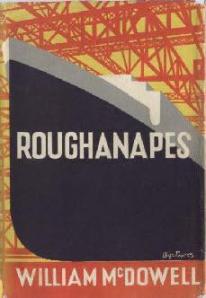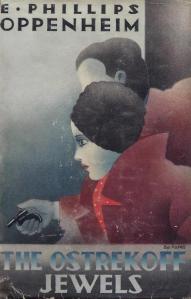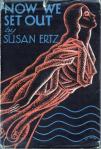
Source : http://www.ClassicCrimeFiction.com
Bip Pares – it’s a name that comes up every year at the London Rare Books School as we trace the evolution and bibliographical importance of the dust-jacket – a name seen so often on some of the most eye-catching designs of the nineteen-thirties and forties. But no-one seems to know very much about who this artist and illustrator actually was. A scattered handful of biographical snatches has appeared on the internet in recent years – some contradictory and others slightly inaccurate. Let’s try to set at least part of the record straight.
Ethel “Bip” Pares was born on 27th February 1904 in the Thames-side village of Clewer, just beyond Windsor. She was the second child of the marriage of Basil Pares (1869-1943) and his wife Caroline Evelyn Whistler (1874-1959), who had married in Norfolk in 1902. Her father was a younger son of the well-to-do family of John and Katharine Pares. A Lancing and Cambridge (Emmanuel) man, Basil Pares became a surgeon, served as a civilian in the South African wars of 1899-1901, and then transferred to the army, becoming Surgeon-Major of the Royal Horse Guards in 1906. He served in the Great War, picking up a DSO in 1915 and a CMG in 1916, and was mentioned twice in despatches.
We first catch glimpse of the young Ethel Pares on the 1911 Census, living at evidently spacious Elgin Lodge in Windsor. Her father was away visiting his widowed father on Census Night, but at home at Elgin Lodge were her mother and her three siblings – elder brother George Martin Pares (later to marry an admiral’s daughter and become a Commander in the Royal Navy), younger sister Evelyn, and baby Stephen – together with a nurse, a cook, a housemaid and a parlourmaid. Her mother, generally known by her second name as Eve or Evelyn, was the daughter of George Lambert Whistler, a tea-broker, and his wife Emma St. Aubyn Gregory. There were later to be two further children, Basil and Constance Pares, both of whom died in 1939-1940 – Basil killed at sea. [*Correction – the Constance Pares who died in 1939 was an aunt, not a sister: I am very grateful to Hugh Lewis for pointing out the sister Constance (always called Kon and an excellent landscape painter and portraitist) lived until 1996].

Source : http://www.greatwardustjackets.co.uk
Ethel Pares had been named after an aunt, but her pet family name of Bip (apparently deriving from her infant attempts at pronouncing the name of a family horse) became the one which she used professionally and even quite frequently on official records and documents. She studied at the Slade in the early twenties and took to a career as a commercial artist, producing illustrations and posters (including some fine examples for London Transport) as well as dust-jackets.
In 1932 she was living with flatmates at 9a Hampstead High Street, next door to the old King of Bohemia public house. On 30th September 1933, at the age of twenty-nine, she married Alfred Trevor Gwyn Thomas, a medical man like her father, then attached to St. Mary Abbot’s Hospital in Kensington. A few months her junior, he was the Newcastle-born son of a Welsh clergyman. The marriage took place at Horsell, near Woking, in Surrey – the service conducted by her uncle, Norman Pares, who was the vicar.
The marriage did not last long. Her husband appeared just once on the electoral register at 9a Hampstead High Street – in 1934. In 1936 she petitioned for divorce. Her husband is last heard of sailing for Mombasa in 1946. New flatmates at this time included Eric Vernon Francis, writer on politics and economics, and Frederick Elwyn Jones, later Baron Elwyn-Jones, the Welsh barrister and Labour politician.

Source : http://www.ClassicCrimeFiction.com
Bip Pares’ second marriage took place at Hampstead in 1938. Her new husband was Robert Christopher Bradby (1905-1982), son of Henry Christopher Bradby (1868-1947), master at Rugby School and a minor poet. The honeymoon was spent exotically in the Himalayas, taking advantage of the opportunity afforded to travel with the British Everest Expedition which set out that year under Bill Tilman. Her own account of the journey was published by Hodder & Stoughton in 1940 as “Himalayan Honeymoon”, complete – of course – with her own illustrations.
On their return, the couple settled at 20 Frognal Lane, Hampstead. Her husband served in the war, gazetted second-lieutenant in 1940. By 1948 this marriage too had broken down and they were living apart. Bip Pares moved to 18 Hollycroft Avenue, Hampstead, where she remained until at least 1965, and probably for the rest of her life. Her death aged seventy-three was registered in Hampstead in 1977. Her final years are said to have been plagued by ill-health.
Her best and most striking work was done in a highly commercial British art-deco style. Her more naturalistic designs, although pleasing, are (to my eye at least) a little less successful in comparison. She seems almost to have relished the challenge of working in a cost-controlled exercise limited to two or three colours. Her designs are bold. Her use of colour confident and assertive. Her handling of lettering purposeful and assured. There is a distinctive vitality which stands comparison with the very best of twentieth-century design. One measure of her success and broad appeal is that her designs were very often retained for the American editions of the books she had worked on – something very rarely the case at this period. She has long been admired and collected – but as she is said to have designed some 600 dust-jackets in all, there are plenty of examples still out there waiting to be found. You may well find some at this week’s York National Bookfair – I’ll be there looking as well.






Bravo, Laurence!
Enormously interesting and nicely written. And I do indeed remember the discussion during London Rare Books School. This certainly makes me want to learn more about her dust jackets (and maybe even collect them). What great talent. Thanks so much.
LikeLike
Thank you, John – good to hear from you. I’m looking forward to reading Brigitte’s LRBS essay on three other dust-jacket designers of the period. Are there any other half-forgotten dust-jacket designers out there that anyone would like to hear more about?
LikeLike
There is a short biography & bibliography of Bip Pares in Studies in Illustration #21 published by The Imaginative Book Illustration Society (www.bookillustration.org) with some additions to the bibliography in issue #30
LikeLike
Many thanks for this – something I’d completely missed.
LikeLike
Excellent article which just shows up my ignorance – I didn’t even know that Bip Pares was a woman. There are several more of her designs on my Great War Dust Jackets website.
Another female jacket designer from the same period would be Helen McKie whose pictures adorned many books of War memoirs in the early years.
LikeLike
Many thanks. I’ll pull something together on Helen Madeleine McKie for a future post – if you have any favourites amongst her jackets, do send me a scan. All best, Laurence.
LikeLike
Most interesting, but one incidental error to be corrected. Constance (always called Kon and an excellent landscape painter and portraitist lived until 1996). Basil her brother was killed in HMS Ardent.
LikeLike
Thank you so much for this correction. It was her aunt, also Constance Pares, who died in 1939. A note has been added to the text.
LikeLike
Thank you kindly…for me, Bip Pares lives on for her jackets for Eric Shipton’s Himalayan books. I have Bip’s autobiog Himalayan Honeymoon but have yet to find/see a jacket for this book which assuredly she must have done…and have yet to talk to a dealer who has seen one. Have you seen one….if so, can you send me a scan? Thank you Colin Monteath New Zealand.
LikeLike
Thank you for this, but – no – I’m afraid I’ve never come across one. Can anyone else out there help?
LikeLike
I’ve just noticed a dealer on ABE, Sulis Fine Art, has some 10 drawings by Bip Pares on offer – mostly under £20 each.
LikeLike
Well spotted!
LikeLike
Pingback: Pan-tastic! Mr Perrin and Mr Triall, Henry Walpole | roughread
Reblogged this on BookAddiction.
LikeLike
Pingback: The First Years of Pan – PENGUIN SERIES DESIGN
I can provide more information on the first husband, A.T.G. Thomas. After service in the RAF, he became the Medical Officer of Health in Nairobi, a post he held until 1961. He’s quite influential in terms of the development of Nairobi (and the suppression of the Kenya Land Freedom Army – aka Mau Mau — in that city).
LikeLike
Thank you so much for this – it all helps fill in the broader picture.
LikeLike
I believe most of Ms. Pares’ jackets were done for Hodder, but for collectors, I’ve just found an early one for Nash & Grayson, a novel called “Prologue to Freedom” by Michael Romain, 1931, in three shades of blue. I’m also still hunting for a jacket for “Himalayan Honeymoon.”
LikeLike
Has anyone compiled a list of Pares jackets?
LikeLike
Many apologies – I seem completely to have missed the comments when they came in. I certainly don’t know of a list of all the Bip Pares jackets, but someone should certainly attempt one. They always light up the shelves when you find one.
All best, Laurence.
LikeLike